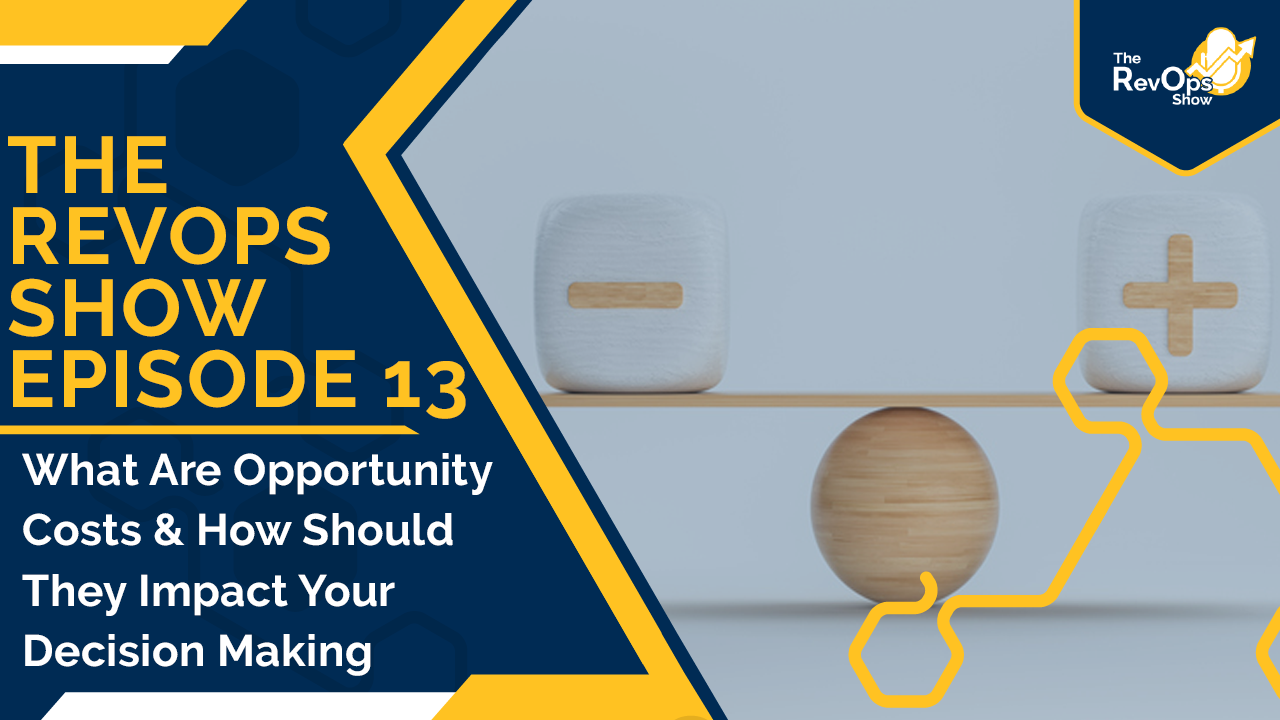At Imagine we have what are called The First Principles for Radical Execution. Here, we’re looking at one that isn’t understood as easily, consider the opportunity cost. Doug and Jess will walk you through what that means, and how you apply it in RevOps.
Audio:
Video:

Additional Resources:
Show Notes:
What does consider the opportunity cost mean?
Opportunity cost considers what else you could do, so it means laying out all your options. But this isn’t necessarily right and is a perfect example of not taking into account opportunity cost. If you were to lay out all your options, the amount of time that it’s going to take to lay out all your options isn’t going to be worth it.
One of the battles that Doug takes with people that have become super proponents of RevOps, is that it’s very common for people to say RevOps needs to be a key discipline from the first person. When you’re below a certain size, scale, and/or scope, there’s RevOps things that are always happening. But to pay attention to reducing friction before you get to a critical mass of force is the opportunity.
Doug can’t say it’s wrong to make sure that your database is completely clean. He can’t say it’s wrong to have all non-relevant data.
Another element of opportunity cost is consider the opportunity value which is where your highest leverage areas are. Think of it this way, if things were working better, what else would you be able to do if this were not a problem? So if pipeline insights were not a problem, what else would you be able to do?
As Jess was doing some research, she always heard opportunity costs talked about in the negative. She was finding that you have to consider what you lose, and here what she’s hearing from Doug is you have to consider both what you lose and what you gain by the decision you make. When you hear “costs” that’s often thought about as negative.
Doug would say that cost could be positive or negative. Opportunity costs really come in when you’re dealing with constraints. At some point you have to make a choice of this or that and that’s where the opportunity cost is because if you do this then you can’t do the other thing now. Sometimes that’s resource related, and sometimes it’s path related.
There’s always trade-offs, and that means there are advantages and disadvantages. When you make a choice, that's an opportunity cost because you want the advantages, but you have to accept the disadvantages as a result. They’re going to be frustrating and possibly negative.
Here’s a great example of opportunity cost: when Jess talks about adoption one thing you have to do to help drive it is make it easier for the person using the CRM to do whatever they’re doing in the CRM, which is going to take time. It’s going to take resources to figure that out and build that into the structure. If that’s your end goal, you want to spend time upfront planning to make sure it’s easier for the sales rep to go in and log the things and the activities they do. But as a reminder, adoption or utilization is not the goal. Your goal is not to have a 100% utilization. The opportunity cost of that heavy focus is where the cure gets more expensive. If you build a path that’s more consistent and enables less change, you have less opportunity cost.
How do you determine what change is? If we’re trying to manage the opportunity cost and we’re trying to make a rapid change, how do you know how much you change and how rapidly? How do you know that you’ve gone too far?
There’s no opportunity cost calculator. There’s no question there’s going to be places where you run into a little bit of change resistance. If you don’t run into change resistance then you’re probably not pushing hard enough. If you look at implementation over a ramping up of capabilities, you’ll have more capabilities. There is no single, right way.
Doug was talking with an analyst the other day and Doug said the problem in the market right now that scares him, both from an investment standpoint and from a business standpoint is, we’re in one of those crazy periods right now where you’re not rewarded for being smart. In many ways you’re actually rewarded for being dumb. So how do you know what your opportunity cost is? You can make the argument, what would you like it to be? You can use opportunity cost as a rationale for anything.
The scientific method is, what’s your hypothesis? Then as the data comes in, the data influences your decision. You don’t follow the data blindly, but if you have a strong hypothesis, you’ll more often than not increase your decision quality.
Doug ends us off with two things people should take away from this episode. One of the questions that Doug is always striving for us to ask at Imagine is, “If I do this, what am I not doing because of what, and what would I be better doing instead?” So, what is the impact if I do this, what’s the downstream, what’s the next day impact of doing that versus something else?
Next Steps:
-
Follow Jess, Doug & Imagine on socials for updates on the show or other insights:
-
Doug Davidoff: Twitter - @dougdavidoff | LinkedIn
-
Jess Cardenas: Twitter - @JessDCardenas | LinkedIn
-
Imagine Business Development: Twitter - @DemandCreator | LinkedIn
-
-
Subscribe to the show on Spotify & Apple Podcasts
-
Check out Let's Play RevOps on Twitch for more commentary on this topic
-
Listen to Episode 14: Cracking the Code to Sales & Marketing Alignment
